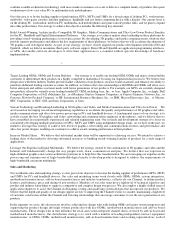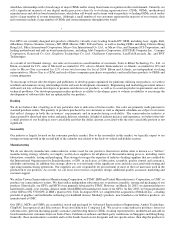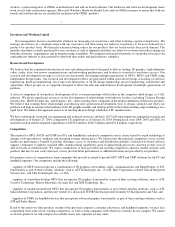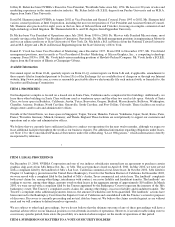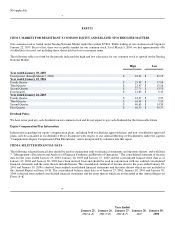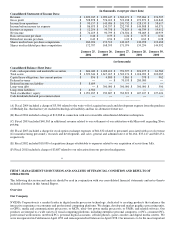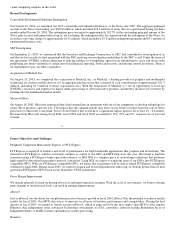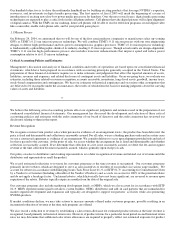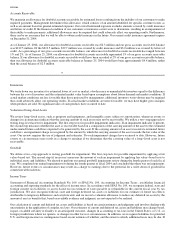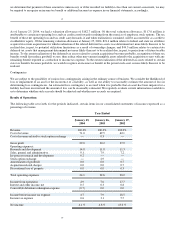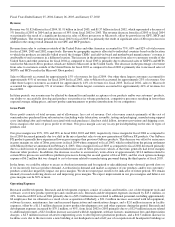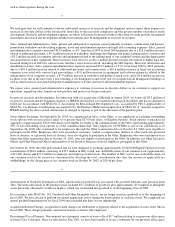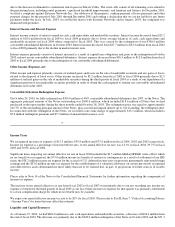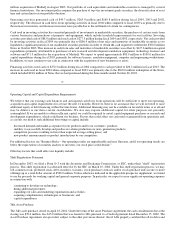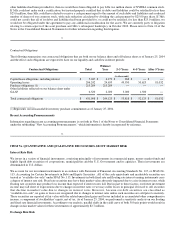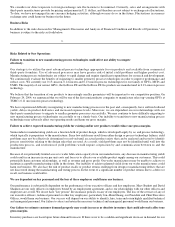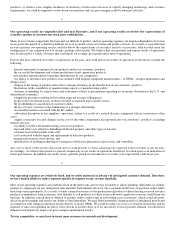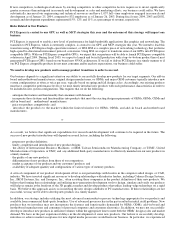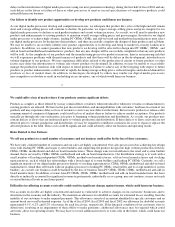NVIDIA 2004 Annual Report Download - page 16
Download and view the complete annual report
Please find page 16 of the 2004 NVIDIA annual report below. You can navigate through the pages in the report by either clicking on the pages listed below, or by using the keyword search tool below to find specific information within the annual report.
returns.
Accounts Receivable
We maintain an allowance for doubtful accounts receivable for estimated losses resulting from the inability of our customers to make
required payments. Management determines this allowance, which consists of an amount identified for specific customer issues as
well as an amount based on general estimated exposure. Our overall estimated exposure excludes amounts covered by credit insurance
and letters of credit. If the financial condition of our customers or insurance carrier were to deteriorate, resulting in an impairment of
their ability to make payments, additional allowances may be required that could adversely affect our operating results. Furthermore,
there can be no assurance that we will be able to obtain credit insurance in the future. Our current credit insurance agreement expires
on December 31, 2004.
As of January 25, 2004, our allowance for doubtful accounts receivable was $2.3 million and our gross accounts receivable balance
was $219.5 million. Of the $219.5 million, $39.7 million was covered by credit insurance and $3.0 million was covered by letters of
credit. As a percentage of our gross accounts receivable balance, our allowance for doubtful accounts receivable has ranged between
1% and 2%. As of January 25, 2004, our allowance for doubtful accounts receivable represented 1% of our gross accounts receivable
balance. If our allowance for doubtful accounts receivable would have been recorded at 2% of our gross accounts receivable balance,
then our allowance for doubtful accounts receivable balance at January 25, 2004 would have been approximately $4.4 million, rather
than the actual balance of $2.3 million.
14
Inventories
We write down our inventory for estimated lower of cost or market, obsolescence or unmarketable inventory equal to the difference
between the cost of inventory and the estimated market value based upon assumptions about future demand and market conditions. If
actual market conditions are less favorable than those projected by management, additional inventory write−downs may be required
that could adversely affect our operating results. If actual market conditions are more favorable, we may have higher gross margins
when products are sold. No significant sales of such products have occurred to date.
Valuation of Long−lived Assets
We review long−lived assets, such as property and equipment, and intangible assets subject to amortization, whenever events or
changes in circumstances indicate that the carrying amount of such assets may not be recoverable. We utilize a two−step approach to
testing long−lived assets for impairment. The first step tests for possible impairment indicators. If an impairment indicator is present,
the second step measures whether the asset is recoverable based on a comparison of the carrying amount of the asset to the estimated
undiscounted future cash flows expected to be generated by the asset. If the carrying amount of an asset exceeds its estimated future
cash flows, an impairment charge is recognized by the amount by which the carrying amount of the asset exceeds the fair value of the
asset. Our review requires the use of judgment and estimates. No such impairment charges have occurred to date. However, future
events or circumstances may result in a charge to earnings if we determine that the carrying value of a long−lived asset is not
recoverable.
Goodwill
We utilize a two−step approach to testing goodwill for impairment. The first step tests for possible impairment by applying a fair
value−based test. The second step (if necessary) measures the amount of such an impairment by applying fair value−based tests to
individual assets and liabilities. We elected to perform our annual goodwill impairment review during the fourth quarter of each fiscal
year. We completed our annual impairment test during the fourth quarter of fiscal 2004 and concluded that there was no impairment.
However, future events or circumstances may result in a charge to earnings due to the potential for a write down of goodwill in
connection with such tests.
Income Taxes
Statement of Financial Accounting Standards No. 109, or SFAS No. 109, Accounting for Income Taxes , establishes financial
accounting and reporting standards for the effect of income taxes. In accordance with SFAS No. 109, we recognize federal, state and
foreign current tax liabilities or assets based on our estimate of taxes payable or refundable in the current fiscal year by tax
jurisdiction. We also recognize federal, state and foreign deferred tax assets or liabilities for our estimate of future tax effects
attributable to temporary differences and carryforwards; and we record a valuation allowance to reduce any deferred tax assets by the
amount of any tax benefits that, based on available evidence and judgment, are not expected to be realized.
Our calculation of current and deferred tax assets and liabilities is based on certain estimates and judgments and involves dealing with
uncertainties in the application of complex tax laws. Our estimates of current and deferred tax assets and liabilities may change based,
in part, on added certainty or finality to an anticipated outcome, changes in accounting or tax laws in the United States, or U.S., or
foreign jurisdictions where we operate, or changes in other facts or circumstances. In addition, we recognize liabilities for potential
U.S. and foreign income tax contingencies based on our estimate of whether, and the extent to which, additional taxes may be due. If



